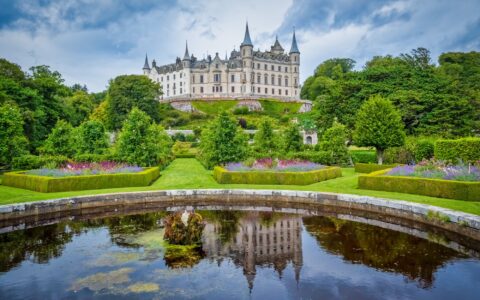Dunrobin Castle in Scotland is one of the Highlands’ most majestic and imposing castles. It was the magnificent home of the Earls and Dukes of Sutherland for over 700 years! With its stunning architecture and breathtaking views, the building is a must-see for any visitor to Scotland. It has to be said that each generation has brought its own touch to the building, adding luxurious and remarkable improvements over the centuries!
From the grand entrance hall to the lush gardens, you’ll be captivated by the beauty of the place. Discover the unique atmosphere of a Scottish castle with its grandeur and tradition, and enjoy breathtaking views of the coast!

Dunrobin castle – © Luis
Dunrobin castle is thought to have emerged during the 13th century, and was first mentioned as a family stronghold in 1401.
The first castle was in fact a fortified square keep, with walls almost 2 meters thick! Built on a rocky promontory, it was constantly transformed and improved over the centuries.
The castle’s first known owner was the 10th Earl of Sutherland, who was master of such a vast territory that he was reputed to have declared that he intended “to go south to the Wear, build a castle on the Severn and build a bridge over the Thames“.
In other words, his influence was such that it was almost mandatory for him to build a grandiose castle! A way of asserting his power over the region and demonstrating his wealth to the population.
Thus, the château was improved in the 16th century, with a major extension in 1785. As for the keep, it remained true to its origins, with only minor improvements.
However, the castle was significantly altered around 1845, when Sir Charles Barry, architect to the Parliament of London, was called in to rethink the building. His brief was clear: he was to transform the castle into a Scottish baronial house, in the same style as Queen Victoria’s new residence at Balmoral.
Inspired by the French art of the time, he laid out superb formal gardens, multiplied the ornamentation and added a touch of luxury and grandeur to the whole.
Unfortunately, the château was partially destroyed by fire in 1915.
Another architect, Sir Robert Lorimer, set about restoring the building in the spirit of his predecessor, adding a “Scottish Renaissance” style.
After the death of the 5th Duke in 1963, the castle passed into the hands of the Countess of Sutherland, who transformed the building into a boarding school for boys.
After a decade, the castle reverted to a family home, before opening to the public.
Dunrobin Castle is one of Scotland’s most popular tourist attractions. It’s a magnificent place, as much for its architectural beauty as for its particularly rich history.
It’s a stunning example of a medieval castle, with its imposing stone walls, turrets and deep moat. Its many transformations make it a fascinating ensemble, telling the story of over 700 years of Scottish history.
Inside, numerous exhibits tell the story of the castle and the Sutherlands. There are also many interactive activities for children.
To better understand the visit, it’s important to know that Dunrobin Castle consists of a series of buildings, including the Great Tower and the Great Hall, all of which are linked by a variety of staircases, long passageways and a large number of ornate doorways.
There is also a small garden adjacent to the castle, with a fountain and moat surrounding it.
The great tower is the most impressive part of Dunrobin Castle. All the main living areas are located on the upper floors of the tower, with the Great Hall on the top floor.
There are several exhibition rooms on the lower floors, including the Weaving Room, Tapestry Room and Firearms Room.
The Great Hall is the most recognizable feature of Dunrobin Castle, with its high, impressive wooden roof. It is one of the largest rooms in the castle, with a seating capacity of 100. It’s also the only room in the castle with a 13th-century sandstone fireplace.
The library, meanwhile, is a small, welcoming room containing many rare books dating from the 14th and 15th centuries. Among the most notable books are the Book of Dunrobin, which traces the history of the castle’s owners, and the Book of Hours, a devotional book written in French.
Dunrobin Castle is fully accessible to visitors of all levels. The Great Hall and Tapestry Room, as well as the first floor of the Great Tower, are fully accessible by elevator. The upper floors of the Great Tower, as well as the weaving room, are accessible by staircase, with a ramp on one side.
The rest of the castle is accessible via a network of stairs, with a handrail on both sides. All Dunrobin Castle toilets are accessible to disabled visitors. There is also a disabled parking space and a dropped kerb at the main entrance. To visit the castle, it is advisable to call ahead, as no special assistance is available onDunrobin Castle in Scotland is an absolute must-see in the Highlands! A majestic site, steeped in 700 years of history! site.
 Address:
Address:
 GPS :
GPS :
 Visit duration:
Visit duration:
 Site Web :
Site Web :